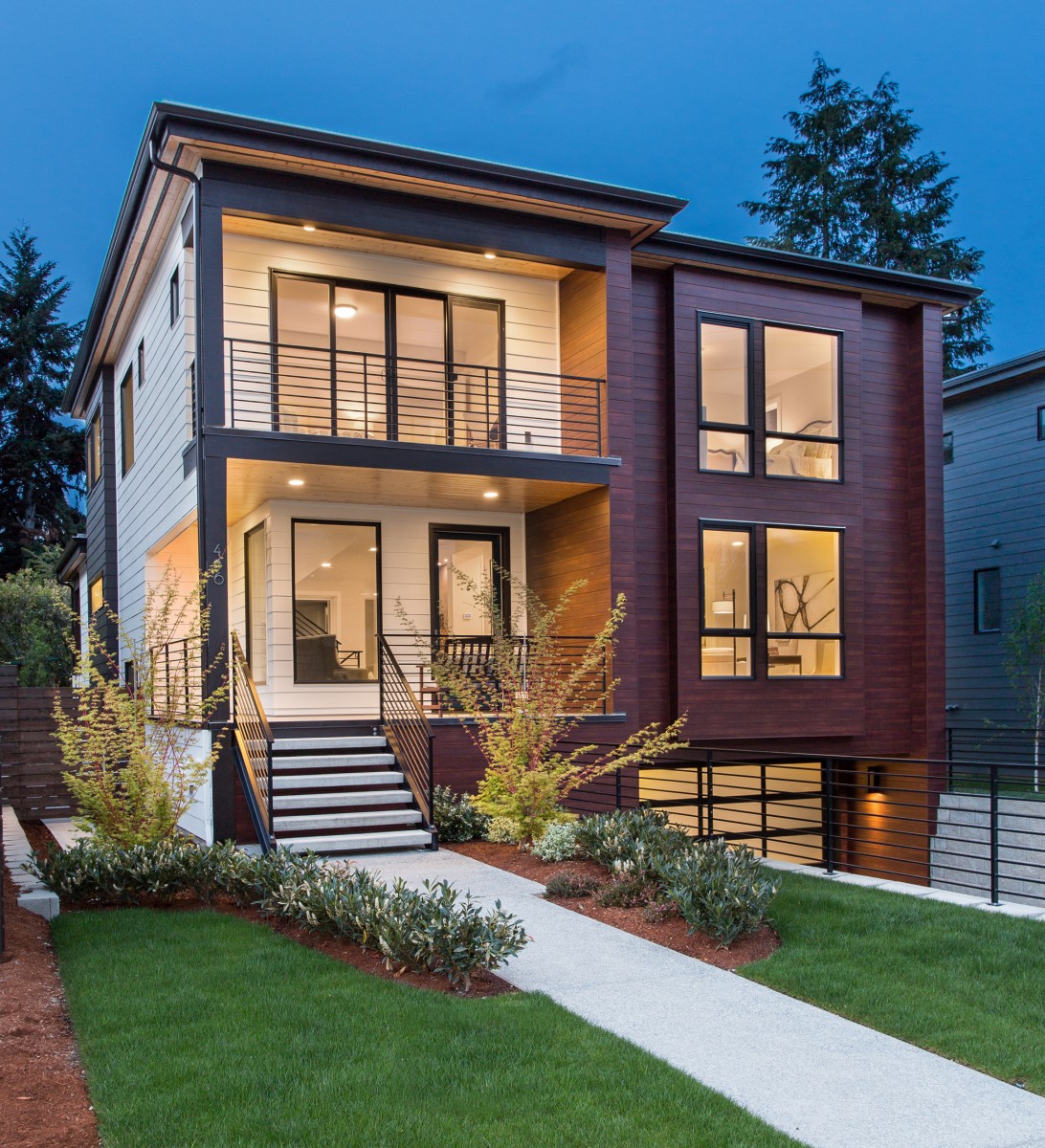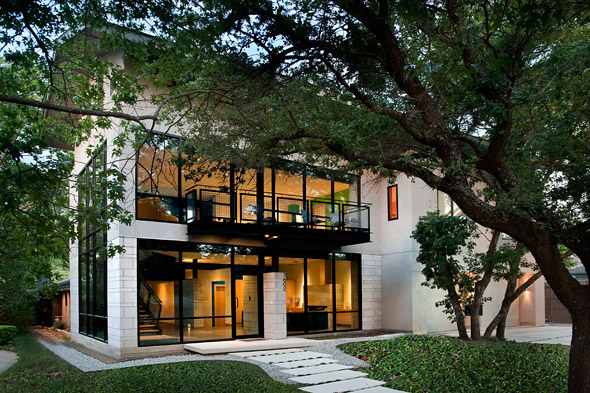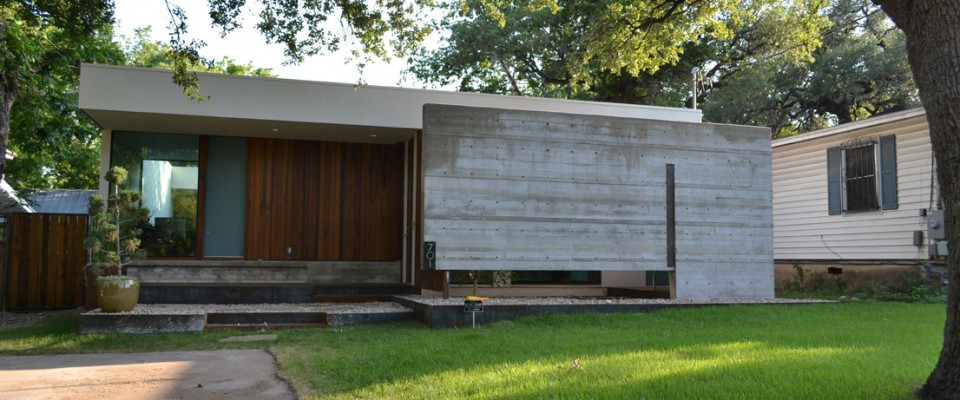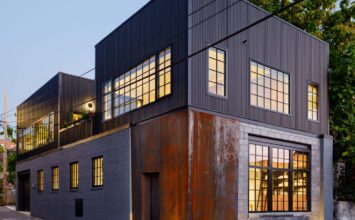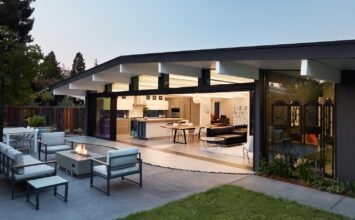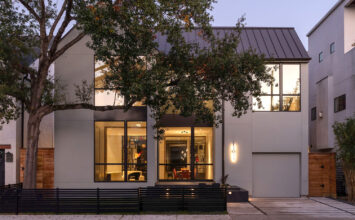Developed in association with Gray Magazine, Modern Home Tours is proud to present the 2016 Seattle Modern Home Tour!


DATE: Saturday, April 30, 2016
TIME: 11:00am – 5:00pm
COST: $35 USD Online in advance, $40 day of
LOCATION: Greater Seattle Area
TRANSPORTATION: Self-driving, Self-paced
Advance tickets are on sale through FRIDAY, April 29 at 5PM for $35 each. Tickets purchased after that time MUST be purchased at any of the tour homes beginning at 11:00 am on Saturday, April 30 for $40 each. Children 12 and under are free.
A) Kirkland, WA
Architect: Jim Dwyer
Builder: BDR Homes
This new luxury home features over 3,500SF and 4 bedrooms plus a den. The large innovative covered outdoor room is designed for year-round living, featuring heaters, a fireplace, and TV. The expansive roof-top decks are the perfect place for fair-weather entertaining. Living is luxurious and convenient in this modern home that is appointed with $100,000 in “BDR Luxury Features”. The modern open-concept layout gives the home an airy and expansive ambiance. Enjoy the convenient location situated just minutes from Google’s Kirkland campus, Microsoft Campuses, and Downtown Bellevue. While major employment centers in downtown Seattle are just a short 15 minute drive away.


B) Seattle, WA
Architect: Robert Bonner
Robert Bonner Design
Photos: Robert Bonner
This Northwest Modern home is at the Iconic location in Seattle, Alki. This property sits beside the shores of Puget Sound, where you watch Ferry boats travel to Bainbridge, among the over 400 other San Juan Islands. This home flows as Circulation was the most important function to minimize to maximize the functional floor area. The Main floor has a split entry with a double Cantilever Master Bath above to greet you and invite you into the Grand Entry, Nana Wall which opens to the Sound. The Kitchen and Dining Room is gracious as the Rear Room can function as an Office or another Bedroom. The Lower Level is a possible Mother In Law level with W/D hookups. As you climb up the stairs, you can see all the way up to the Penthouse level and see how the Staircase transforms into a tighter space and to allow a lot of light into the home. The Upper Floor Has Beautifully high Cathedral ceilings that allow the Pacific Northwest Rain to fall and form another function, Solar Energy. The Master Bedroom has a large Walk-In-Closet, a Covered Deck and a Master Tub that Double Cantilevers over the edge so you feel like you’re on the bow of a ship. Go above to the Roof and now you are sitting on a Double/Double Cantilever.

C) Seattle, WA
Architect: Thomas Schaer
SHED Architecture & Design
After living in a small, outdated midcentury home in Seattle’s Central District for over a decade, the homeowners approached SHED Architecture & Design in 2014 to help reimagine a home that better aligned with their lifestyle.
The homeowners are working professionals and avid gardeners, maintaining a lush vegetable garden and active chicken coup on the urban site. SHED Architecture & Design worked closely with the client to achieve an open layout, dedicated outdoor workspace, and direct connection from the garden to the new farm-style kitchen.
The economic-driven project was built utilizing as much of the existing footprint as possible. The use of the original front stoop, first floor framing and walls and imaginatively low cost materials helped reduce costs, while allowing the architects to reallocate the budget to other areas like the new roof deck with 360 degree territorial views.

D) Seattle, WA
Architect: Michelle Lanker, Lanker Design LLC
Designer: Gloria Andrade
Photos: Michelle Lanker
This new floating home replaces a houseboat that was originally built at the turn of the century. When that houseboat burned down in 2007, it remained on the water as a burnt shell until early 2015. Below the water were 22 old growth cedar logs perfectly preserved, but the rest of the structure was lost. Fast forward to 2011 when design was conceptualized for a new home.
The idea was to create a structure to showcase design elements that would promote the preservation of shoreline habitat, and to create something that was more than just a personal retreat, but also a call to action. The owner, Bill Bloxom, had lived on a houseboat before and knew what that was like: A close knit community, many visitors, beautiful views, and fun recreation. He also realized it could be a great opportunity to do something different. This could be a chance to give back to the lake somehow and have a positive environmental impact. What if we could improve shoreline with new structures instead of taking away from it?
He hired designer, Gloria Andrade, who visualized a house that would seem to come alive on the water as it breached the surface to take a breath both literally and figuratively. In order to create a home that could be both a refuge and a beacon for change, the whimsical concept had to be infused with environmentally conscience design elements that would be highly visible and easy to operate and maintain.
The core team of Gloria, Bill’s wife and architect, Michelle Lanker, and Bob Little, the contractor, has made sure every detail of the new 2025sf home has been approached from a sustainable viewpoint. Walls and roof are designed with maximum insulation thicknesses/ minimum air leakage possibility. Exterior materials have been chosen for minimum maintenance and maximum durability. The exterior cement fiber wall paneling is installed as a rain screen system to prevent any possible moisture infiltration. 2/3rds of the roof is covered by a 5.32Kw solar array installed over a standing seam metal roof and 1/3rd is a vegetated roof system to help insulate further the interior space. The curved line of the roof lends to making both systems visible to passersby on the water as well as on the dock.
On the inside, finishes have been selected that are made from salvaged, recycled, or rapidly renewable materials as much as possible. The old growth cedar logs were salvaged from the old houseboat and incorporated into the dramatic curved ceiling and built-in elements, windows throughout the house provide purposeful views to the lake and strategic operable locations give the ability to vent the house naturally during warm months. Low-e triple glazing minimizes solar heat gain while still bringing in maximum day lighting. During cold months, the house is heated by a geothermal heating system that captures heat from the lake and feeds a heat pump that circulates the warm water through an in-floor hydraulic loop. LED light fixtures are used exclusively as well as ENERGY STAR appliances and water efficient fixtures. Last but certainly not least, the house is designed to showcase the most important feature, a highly innovative approach to restoring shoreline that is located below the floating home’s deck. In-water planters called floating islands are suspended in the water from the deck structure. They are made from a recycled plastic matrix material that allows the root systems of the native wetland plants that are planted in them to grow through and eventually extend to the water below creating fish habitat. The material also allows friendly bacteria to colonize it as they feed on the excess nutrients in the water, cleaning it and discouraging suffocating algae growth. The concrete float of the home becomes an observation room for studying these floating islands through a large underwater window.
Now that the house has been towed from where it was built in Port Townsend to its permanent home on Lake Union it can become a catalyst for change. We hope this project demonstrates how we can build smarter around our waterways. We can utilize the benefits the lake provides while at the same time be a benefit to the lake. We can inspire as well as be inspired.

E) Seattle, WA
Architect: Susan Jones
AtelierJones
Photos: Lara Swimmer Photography
CLTHouse is a modest, 1,500 sf house for a family of four, including a writer/historian and architect in urban Seattle. Situated on a small, leftover 2,500 sf triangular lot across an alley and rear bank parking lot, the house negotiates between an established neighborhood and the commercial strip off Madison Avenue. The materiality of the house and the interior experiences recall ubiquitous small Pacific Northwest beach cabins, as well as the specifics of the site itself: once a beach itself, under 9’ of water in 1916, before the water levels were lowered by the building of the Ship Canal connecting lake to sea. Inspired by PassivHaus detailing, the highly energy efficient house is rated Built Green 5-star. Inside, the cross-laminated-timber is revealed to the interior domestic spaces and left almost raw, only lightly whitewashed. A new material for the Pacific Northwest, the CLT – from sustainably harvested regional timber – is experienced as a new Northwest beach cabin: a constructed, yet raw, visceral experience of nature. Spatially dynamic, reflecting its triangular site, views are carefully screened, utilities are hidden in a central core, circulation evolves upwards around the core to a roof deck, overlooking the lake. Tectonically experimenting, the CLT panels are routed using CNC technology, evoking the pine knots of the interior, and then vaulted to create visceral experiences of light and space. Clad in burnt, Sho-sugi-ban treated Douglas Fir, the house is blackened on the exterior, revealing a white, immersive natural experience.

F) Seattle, WA
Architect: David Coleman
David Coleman / Architecture
Photos: Fred Housel
This home is located in one of Seattle’s oldest, most established neighborhoods. Our client was sensitive to the look and feel of the neighborhood and to the historical quality of the gambrel-style colonial built in 1907, yet he desired a thoroughly modern living environment; one that maximized the view and light potential of the home and honored his lifestyle. We responded by restoring the exterior of the home to its former glory, and designing a completely new interior within the existing shell. All program functions are located within the existing building footprint and envelope.
The main level includes a two story entry, a storage hall with built-in wardrobes and powder room, a living area with a blackened steel fireplace, a kitchen/dining area, and a small study. The second level includes a master suite with bath, dressing room and reading balcony, a guest suite with bath, and a laundry. An AV room is located on the third level.
This project is a study in simplicity in material, texture and detail. It is intentionally understated and refined, reflecting the tastes and aspirations of its owner. While the new interior harmonizes with the Colonial style of the existing shell, it offers a decidedly modern counterpoint. This relationship of container to contained is similar to that of a piece of fruit. Modern interior design elements are allowed to penetrate the exterior skin in several key locations, expressing the change that has occurred within and inviting a closer look. Details are spare, elemental and quiet. This home is a respite from the city, synthesizing the multiple requirements of time, light and place.
The floor plans are reconfigured to create an open plan. This was accomplished by removing interior partitions and re-working the building’s fundamental structure. The intimacy of the original rooms was retained by way of architectural elements such as freestanding partitions, full height pocket and pivot doors, lighting and soffit variations.
New mahogany doors and windows accent the traditional painted double-hung windows throughout the building. Several oversized rolling doors open the dining area to a new stone terrace made of Norwegian quartzite, visually expanding the room into the adjacent gardens. The landscape (as well as the front porch) will be re-worked as part of a phase II to take advantage of this transparency.
A large stone cooking island separates the kitchen from the dining area. Sinks and countertops are made of fossilized French limestone. Blackened steel structural elements, hardware and fireplace surrounds recall the wrought iron common in colonial homes of the period. Built-in plantation mahogany cabinets permeate the interior and reveal individual room functions.

G) Seattle, WA
Architect: Tiffany Bowie
Malboeuf Bowie Architecture
Photos: Shea Pollard Photography
The Palatine Passive house is an urban infill project in a vibrant and up and coming neighborhood of Greenwood in North Seattle. As a certified Passive House Consultant and certified Passive House Builder, principal architects Tiffany Bowie and Joe Malboeuf combine a highly integrated process through every step of the project.
Thanks to an airtight envelope, continuous high-performance insulation, and managed solar gain, the Palatine Passive home uses 90% less energy than required by standard building code. The design employs a continuously filtered heat and moisture recovery ventilation system, resulting in excellent air quality and temperature-control for a healthy, comfortable living environment. Kirio, a home management & control system, monitors all major energy components, optimizes efficiency based on living patterns, and allows residents to manage lighting, cooling, heating, and ventilation from a simple phone app.
In addition to a high level of efficiency, the Palantine Passive House is aesthetically designed to integrate into the surrounding neighborhood, creating a space that is both inviting and inspiring. The distinctive herringbone façade is fabricated from hand-charred cedar, adding a twist to a classic northwest building material. The dark patina complements the lush, tree-lined neighborhood streets, while the “shou sugi ban” treatment naturally seals the cedar, eliminating the need for regular maintenance in a rainy Seattle climate. Once inside, the large windows and white, minimal interior maximize natural daylight to create a welcoming, bright space.

H) Seattle, WA
Interior Design – Barcelo Homes, Oksana Vasilyuk
Architect: HyBrid Architecture
Welcome to the Arboretum Neighborhood. Ideally located between Capitol Hill and Madison Park, some of Seattle’s most sought-after amenities are within close reach as is downtown Seattle, the University of Washington, South Lake Union and Bellevue. Located just steps from your front door is the Washington Park Arboretum – a 230 acre nature preserve full of wildlife and miles of trails to explore. And lining East Madison Street is an array of dining options to enjoy- Bar Cantinetta, The Harvest Vine, Essential Bakery and Nishino to name a few. These twin residences designed by Hybrid Architecture and built by Barcelo Homes offer luxury design and quality construction typically reserved for custom homes. Open interiors flow seamlessly with the outdoors expanding your living space to two view terraces and a back yard directly accessed from the gourmet kitchen. The topography helps to capture stellar views and an unusual degree of privacy for being in-ctiy. Plus, an interior elevator will make day-to-day living that much easier.

